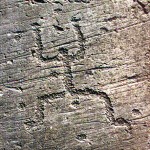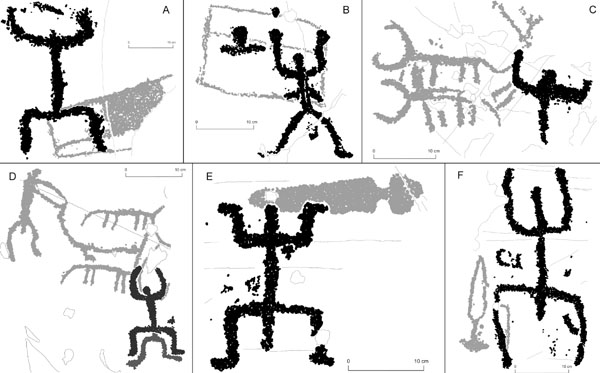
- In Valle r. 4
TRACCE open access papers
Arcà Andrea, 2001.
Chronology and interpretation of the “Praying figures” in Valcamonica rock-art. In: Archeologia e arte rupestre: l’Europa – le Alpi – la Valcamonica, secondo convegno internazionale di archeologia rupestre. Atti del Convegno di studi, 2-5 ottobre 1997, Darfo Boario terme, Milano, 2001, pp. 185-198
| abstract and full text-image inline PDF | English, Italian
Chronology and interpretation
of the “Praying figures” in Valcamonica rock-art
The most important definition of the Valcamonica RA chronology was proposed by E. Anati in the Sixties and fixed in the Seventies. This chronology enlarged the period of engraving activity and postulated the existence of different phases or layers over the engraved rocks. Style I and II were placed during the Neolithic, style III during the Copper Age and Bronze Age, style IV from the end of the Bronze Age to the end of the Iron Age.
A partial revision has been established by the studies of R. C. De Marinis (Copper Age and Iron Age), and of A. Fossati (Iron Age). A better definition of the Copper age phases has been identified, while the first phase of style IV (Iron Age, style IV 1) has been shifted from the final Bronze Age to the first Iron Age, relating the figures of riders only to the Iron Age.
“Prayers” have been placed by E. Anati at the base of the Camunian styles I and II. Style I corresponds to the 5th millennium BC – part of the 4th (5000-3800 BC) and style II to the 4th (3800-3000 BC). Simple or coupled “prayers” belong to style I.
Problems
This chronological attribution has been already questioned. In 1968 Cornaggia Castiglioni rejected Anati’s chronological attribution of styles I, II and III, refusing the archaeological comparisons with Remedello daggers for style II and III and pointing to the lack of any “palethnological support” for the style I. P. Graziosi in his work on prehistoric art in Italy expressed doubts about the Neolithic phases of Valcamonica chronology. In 1983 E. Schumacher26 outlined some methodological shortages in Valcamonica style seriation and suggested a comparison between schematic “prayers” and figures of the Protovillanovian hut-urns (X-IX cent. BC). Recently A. Fossati demonstrated that many “prayers” are indeed weaponed (Naquane and Foppe di Nadro). By the comparison with archaeological weapons, he correctly suggests for them a Final Bronze Age chronology, being impossible such a large number of fakes.

Cherèmule (SS-I), Tomba Branca
Superimpositions
In this paper I would like to present a further contribution. As already outlined by many authors it is not possible to find “prayers” covered by III style figures. On the contrary it is possible to underline at least ten cases where “prayers” superimpose. Each case has been attentively observed and testified under grazing light and with the help of high resolution (2700 optical) picture scanning All the examples demonstrate how “prayers” cover the Neolithic, Copper Age, Bronze Age and in some cases first Iron Age figures.

. Prayers overimposed to: Neolithic – first Copper Age maps (A – Foppe di Nadro 23, B – Paspardo In Valle 9); Copper Age ploughing scenes (C, D – Dos Cuì); Bronze Age daggers (E – Foppe di Nadro 24, F- Foppe di Nadro 23)
Chronological conclusions
All the previous assertions suggest a clear need for redefining the chronology of the Camunian “prayers”. This suggestion is motivated by archaeological comparisons, examination of the spatial distribution, associations (and dissociation) and stylistic considerations. It is mainly testified by the analysis of the superimpositions: as “prayers” superimpose Neolithic-Copper Age maps, Copper Age ploughing scenes and Ancient Bronze Age daggers it is impossible to place them in these periods. A similar conclusion is suggested by the fact that “prayers” are never associated with Remedellian and Bell-beaker elements. On the contrary the contiguity and the repeated co-occurrence of “prayers” with Iron Age figures opens the door to a Middle-Recent Bronze Age-Final Bronze Age range, probably reaching in some cases a First Iron Age chronology. This mean a XVII-VIII cent. BC theoretical range, which could be restricted by some two-three centuries (XV-VIII BC) by assuming that the bay-leaf spear point (which represents the most ancient superimposition related to an object archaeologically dated) depicted in the Costa Peta rock pertains not to the first but to the middle part of its chronological duration.

Prayer overimposed to a Neolithic – first Copper Age map: Foppe di Nadro 23
RIASSUNTO
La cronologia degli oranti, attualmente alla base degli stili I e II (Neolitico) della seriazione camu na, viene affrontata partendo dalle revisioni in atto. Viene illustrata una serie di sovrapposizioni di oranti a figure dell’età del Rame, del Bronzo e della prima età del Ferro. Sulla base di tali sovrapposizioni, della ripetuta contiguità spaziale con figure dell’età del Ferro e del studio della Rupe Magna di Grosio si ipotizza una cronologia Bronzo Medio-Recente Bronzo Finale, con attardamenti fino alla prima età del Ferro. Nella presenza di coppie di oranti e di oranti armati si riconosce un’anticipazione delle tematiche connesse alle prove di abilità e di forza dell’età del Ferro, con la possibile raffigurazione di lotte a corpo libero e con un aggancio alle scene di danza per quanto riguarda le figure femminili, in un contesto iconografico legato ad eventi di rito-gioco-festa. Si sottolinea la forte problematicità delle prime due fasi della seriazione stilistica camuna e si propone di assegnare allo Stile I il periodo proto-camuno e allo Stile II le incisioni topografiche.














Leave a Reply